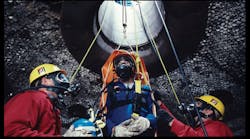Trenches don’t have to be dangerous. With proper shoring, appropriate atmospheric monitoring, the knowledge of an educated and experienced “competent person” and employee training, tragedies involving trench collapses can be avoided.
”Unfortunately, a number of employers feel that it’s easier, faster and cheaper to cut corners,” says Ira Wainless, who recently retired as a senior industrial hygienist with OSHA, having spent 40 years in the field of occupational safety and health. Despite a National Emphasis Program launched by OSHA that targets trenching operations, employers continue to be cited for trenching hazards. One Massachusetts contractor who primarily is engaged in the construction of underground water and sewer mains has been cited eight times for repeat violations of OSHA’s trenching and excavation safety standards since 2000. According to OSHA, 200 workers across the country have died in trenches since 2003, with hundreds more injured.
Cave-ins pose the greatest risk and are much more likely than other excavation-related accidents to result in worker fatalities. Other potential hazards include falls, falling loads, hazardous atmospheres and incidents involving mobile equipment.
“People tend to minimize the dangers of a trench,” says Don Ellenberger, environmental hazard training director for CPWR – The Center for Construction Research and Training. “They do not take it as seriously as it needs to be taken as a hazard.”
What many workers – and employers – fail to remember is that 1 cubic yard of soil can weigh as much as a car.
Protective Systems
OSHA requires that trenches 5 feet (1.5 meters) deep or greater require a protective system unless the excavation is made entirely in stable rock. If less than 5 feet deep, a competent person may determine that a protective system is not required. Trenches 20 feet (6.1 meters) deep or greater require that the protective system be designed by a registered professional engineer or be based on tabulated data prepared and/or approved by a registered professional engineer in accordance with 1926.652(b) and (c).
Wainless says that some of the aspects of trenching safety that contractors overlook are factors such as depth and width of the trench, type of soil, water content of soil, ground water seepage, environmental conditions (including potential changes in the weather), proximity to previously backfilled excavations, weight of nearby heavy equipment or tools and vibrations from machines and motor vehicles in close proximity to trenching operations. These factors can greatly affect soil stability and the hazards that workers face.
“Workers who dig or excavate trenches are at risk of death if they enter an unprotected trench and the walls collapse,” says Wainless. “Lack of a protective system was the leading cause of trench-related fatalities in a review of OSHA inspections.”
A trenching system that provides support to the walls of the trench and a method of entrance and egress within a few feet of where employees are working can save lives.
Speaking Up
“Construction workers are not trained in the hazards of trenches,” says Ellenberger, and even when they are, they still enter trenches they know are unsafe, he adds.
“Maybe they’ve entered a trench like that 100 times before and nothing has happened. They see other workers in the trench and they’re fine. They are afraid to say anything for fear of losing their jobs,” he says, checking off reasons why trained workers might enter an unsafe trench. “They need to know that the competent person has evaluated the safety of that trench every day before they go into it.”
In order to stay safe, Wainless suggests employees:
➤ Do not enter an unprotected trench, even for a short task.
➤ Inspect the protected trench before entering.
➤ Exit the trench and call the competent person if they see any evidence of problems with a protective system.
➤ Do not assume there will be a warning sign before a cave in or that they will have time to move out of the way.
Both OSHA and NIOSH offer guidance and resources related to trenching and excavation safety. OSHA, in fact, recently released new guidance materials, including a fact sheet, a poster and an easy-to-reference QuickCard. CPWR created a new trenching hazard alert, as well, which you can find on its Hazard Alert page.
“We just want workers to hesitate long enough to get them to ask the question: Is it safe for me to do this?” says Ellenberger.

